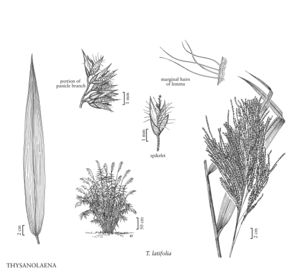Thysanolaena latifolia
Sheaths mostly glabrous, margins often ciliate distally; collars pubescent; blades 20-65 cm long, 2-7(10) cm wide, flat, usually glabrous or mostly so on both surfaces, occasionally sparsely pubescent abaxially, adaxial surfaces often pubescent immediately distal to the collar and ligule. Panicles 17-140 cm; branches to 75 cm, often drooping, pulvini pubescent. Spikelets 1.2-2.8 mm, frequently abortive. Lower glumes 0.5-0.9 mm, broadly ovate; upper glumes 0.5-1 mm, broadly elliptic; lower lemmas 1.3-2.4 mm, elliptic lanceolate, acute to acuminate; upper lemmas 1.2-2.8 mm, lanceolate, acute to acuminate; anthers 0.6-1 mm, yellow; stigmas purple. Caryopses 0.4-0.5 mm. 2n = 24.
Discussion
Thysanolaena latifolia is an important pasture species in Asia. It is grown in the United States as an ornamental plant, recommended for frost-free areas with full sunlight or light shade. It is not known to be established in the Flora region.
The species has been known as Thysanolaena maxima (Roxb.) Kuntze, but Baaijens and Veldkamp (1991) demonstrated that T. latifolia has priority at the species level.
Selected References
None.
